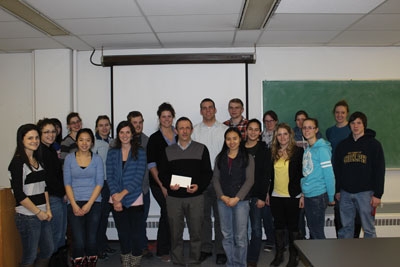
Nurturing an Early Interest
By Treena Hein
Features Health Turkeys Poultry Research Protection ResearchNews of poultry-related projects at some Canadian universities
 The OAC Poultry Club poses with club advisor Gregoy Bedecarrats (centre, with envelope) and Leanne Cooley, vice-chair, PIC, and Special Events Committee chair, (behind Gregory to the left).
The OAC Poultry Club poses with club advisor Gregoy Bedecarrats (centre, with envelope) and Leanne Cooley, vice-chair, PIC, and Special Events Committee chair, (behind Gregory to the left). Interest in poultry is alive and well among students at the University of Guelph, whose Ontario Agricultural College (OAC) and Ontario Veterinary College (OVC) Poultry Clubs have both worked with the Poultry Industry Council (PIC) on projects since 2009. “These projects help the students develop links with industry, and in some cases earn credits toward their degrees,” says former PIC executive director Tim Nelson. “Industry, in turn, benefits from the new ideas that the students work on.”
For the 2013 school year, the clubs will have extra money for a joint project, thanks to the legacy of the late Bruce Hunter, OVC Professor Emeritus, who, sadly, passed away in 2011. Hunter was an avian disease expert who had a long-standing relationship with the poultry industry, and was working on biosecurity research for small flocks in a joint project with PIC and the Ontario Ministry of Agriculture, Food and Rural Affairs (OMAFRA). The PIC decided to make some of what remained of Hunter’s research grant ($3,500) available to the two clubs for a project that would both honour and respect Hunter’s memory.
Recent OAC Projects
The OAC Poultry Club is made up of students who share an interest in poultry, whether enrolled in an agriculture-related program or not. The club is responsible for data collection, artificial insemination and genetic selection of the Shaver Heritage hens at the University of Guelph’s Arkell Research Station. They also tour poultry facilities such as hatcheries, research farms and grading stations, as well as hold events featuring guest speakers.
During the 2011 school year, the OAC club created an educational DVD to promote proper on-farm biosecurity measures in collaboration with PIC and OMAFRA.
“We placed an emphasis on pathogen transmission and prevention,” says club president, Jacob Pelissero. “Following completion, we did a formal presentation to industry at the PIC Poultry Innovations Conference in 2011.”
During the following school year, the club worked with the PIC on a Turkey Careers Project, an online pamphlet designed to educate students on job opportunities in the turkey industry. Members also started working with PIC to create a safety awareness campaign called 1000 Ways to Die on a Farm.
“It will contrast potentially dangerous farming procedures with the proper safety precautions and procedures,” Pelissero explains. “In a nutshell, we will produce a DVD and an interactive website that will also have a smartphone version.”
The students are helping to generate the idea story-boards and interview questions for veterinarians, producers and industry technicians, as well as provide some information that will be presented on the website. Some students may also help with the filming of the DVD in the spring/summer. The proposed completion date for the project is November 2013.
“As a part of a class and on our own time, we have a weekly meeting to brainstorm ideas and discuss plans for the video,” Pelissero says. “We’ll present a slide show of ideas to a focus group of industry and the project committee members in the spring. The focus group will also be able to provide us with feedback and input on the ideas.”
Many students are also working with OAC club vice-president and graduate student, Kayla Price, on a coccidiosis project.
“It will educate producers about methods of control and biosecurity measures that can help manage coccidiosis in various production and housing systems,” explains Pelissero. “The initial brainstorming on this project will be performed by undergraduate, graduate and veterinary students as well as other industry members. We intend to make this project as informed and end-user centred as we can.”
The project topic for this year, which will be shared between the OAC and OVC Clubs using the new funding, has not yet been decided. It could be focused, Pelissero says, on biosecurity research/education, genetic research and improvements, or new technologies and animal welfare.
Beyond the University of Guelph in Ontario, the Production Animal Club at the University of Saskatchewan’s Western College of Veterinary Medicine recently held a poultry-related lab.
“Province of Saskatchewan Poultry Extension people brought in some daily mortalities so that students were able to perform necropsies and determine causes of death,” says Club spokesperson and vet student Tara Zachar. “It allowed students that have had no experience with poultry to get used to the differences in anatomy from that of mammalian species, and also allowed for more hands-on necropsy experience.”
Zachar is also in the midst of planning tours of a local hatchery and processing plant to try to further broaden the industry knowledge base of vet students. However, neither the University of Calgary’s Association of Veterinary Students’ Production Animal Health Club nor the University of Prince Edward Island vet school’s clubs currently have any activities related to poultry in the works.
For More Information
- Educational DVD on farm biosecurity measures: www.poultryindustrycouncil.ca/2012/06/04/biosecurity-video-of-the-month/
- Turkey Career Project: http://poultrycareers.ca
Print this page